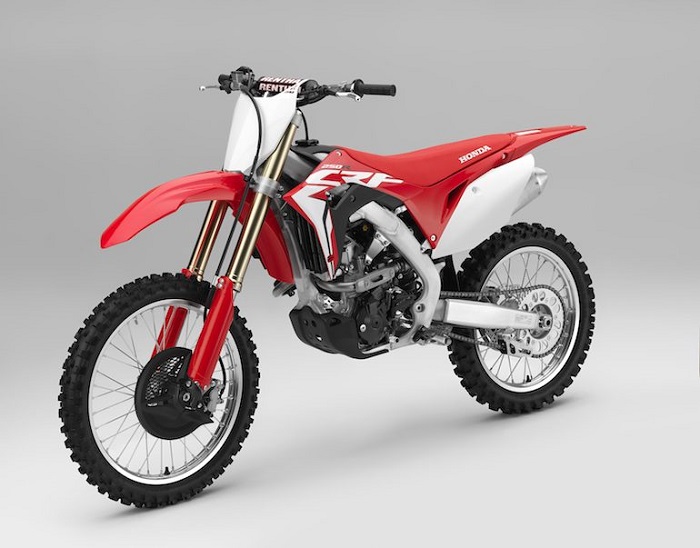Honda Reveals 2018 CRF250R Motocrosser
Honda has unveiled the all-new CRF250R at the AMA Amateur MX Nationals at Loretta Lynn’s Ranch.
Consistent with the "Absolute Holeshot" philosophy of its big brother CRF450R, the highly anticipated motocross model features a host of updates aimed at achieving maximum power and optimum handling.

We're excited to show this all-new, no-compromise model to our customers,” said Lee Edmunds, American Honda's Manager of Motorcycle Marketing Communications. "The CRF450R has become the top-selling 450cc motocross model, and now that the CRF250R shares many of the same performance- focused updates, we're confident it will enjoy similar success in the market and on racetracks everywhere."
To achieve their goal of more high-rpm power, Honda gave the engine an all-new dual-overhead-cam design, using a finger rocker arm with Diamond Like Coating (DLC). The titanium intake and exhaust valves are larger and have a higher lift and narrower angle, while the valve springs' coils now have an oval cross-section to keep engine height as low as possible. The engine has more over-square dimensions, the cylinder offset has been increased, and the piston now features a bridge-box design–a first for a production Honda motocrosser. The new downdraft intake design, twin exhaust ports, and dual exhausts maximize efficiency. An electric starter is standard, powered by a small, lightweight lithium-iron phosphate battery.
The new chassis reduces overall weight, but particularly up high and at the ends of the vehicle. Layout is slim and low, and the machine has superb rear-wheel traction but minimal front-end lift–ideal for strong starting and acceleration. The main spars of the new-generation, lighter aluminum frame are now tapered to optimize flex characteristics and provide good stability and reliable rider feedback, while a shorter wheelbase improves overall agility. An all-new titanium fuel tank and extruded subframe end save weight, and a new Showa coil-spring fork provides plush suspension feel, and a lower, more centralized shock location improves stability.
Source: rideapart.com

We're excited to show this all-new, no-compromise model to our customers,” said Lee Edmunds, American Honda's Manager of Motorcycle Marketing Communications. "The CRF450R has become the top-selling 450cc motocross model, and now that the CRF250R shares many of the same performance- focused updates, we're confident it will enjoy similar success in the market and on racetracks everywhere."
To achieve their goal of more high-rpm power, Honda gave the engine an all-new dual-overhead-cam design, using a finger rocker arm with Diamond Like Coating (DLC). The titanium intake and exhaust valves are larger and have a higher lift and narrower angle, while the valve springs' coils now have an oval cross-section to keep engine height as low as possible. The engine has more over-square dimensions, the cylinder offset has been increased, and the piston now features a bridge-box design–a first for a production Honda motocrosser. The new downdraft intake design, twin exhaust ports, and dual exhausts maximize efficiency. An electric starter is standard, powered by a small, lightweight lithium-iron phosphate battery.
The new chassis reduces overall weight, but particularly up high and at the ends of the vehicle. Layout is slim and low, and the machine has superb rear-wheel traction but minimal front-end lift–ideal for strong starting and acceleration. The main spars of the new-generation, lighter aluminum frame are now tapered to optimize flex characteristics and provide good stability and reliable rider feedback, while a shorter wheelbase improves overall agility. An all-new titanium fuel tank and extruded subframe end save weight, and a new Showa coil-spring fork provides plush suspension feel, and a lower, more centralized shock location improves stability.
Source: rideapart.com
Latest News


